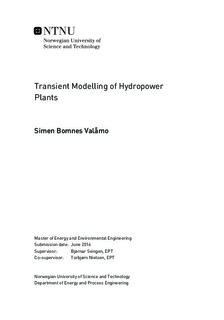Transient Modelling of Hydropower Plants
Master thesis
Permanent lenke
http://hdl.handle.net/11250/2408912Utgivelsesdato
2016Metadata
Vis full innførselSamlinger
Sammendrag
Any changes of the volume flow through a turbine gives acceleration or deceleration of the masses of water in the penstock. This induces dynamic pressure changes in front of the turbine. A pressure transient must be controlled as it can cause severe damage on mechanical equipment, such as a turbine, if it becomes too abrupt. A widely used solution is to decrease the water inertia time constant, by placing surge shafts between the turbine and the reservoirs. Surge shafts introduces U-tube oscillations between the surge shaft and any free surface. These oscillations can give problems if the surges becomes too large. Air can be drawn into the system and cause cavitation near the turbine. Free surface flow in the tunnel can occur and expose the turbine to more stress. The surge shafts must be dimensioned according to the dynamics of the system, which is usually found through numerical simulations.
One dimensional modeling with discrete elements comprising inelastic water and pipes, is a well suited method for simulating U-tube oscillations in hydropower systems. The method is however restricted to a limited complexity of the system to be modeled.
This thesis investigates a solution that aims to enable any system to be modeled with discrete elements of inelastic water and pipes. The use of "Virtual surge shafts" is implemented in a generic simulation program written in Matlab. Four turbine models are implemented to extend the simulation possibilities.
The program is verified with the well known, fully transient simulation program LVTrans. Simulations of two hydropower systems with significantly different complexity is compared to simulation results from LVTrans.
The simulations show generally good compliance with simulations produced with LVTrans. The maximum up surge and down surge deviated with less than 5$\%$ for all simulations.
It can be concluded that the use of virtual surge shafts is a feasible solution, provided that the correct cross sectional is used. The implemented turbine models have enhanced the programs ability to simulate changes on the turbine opening degree, as the turbine characteristics are included.
The feasibility of "Virtual surge shafts" shows to be strongly dependent on the correct cross sectional area. It is recommended with further verification of the solution, to determine if an empirical value of the correct cross sectional area can be established.
